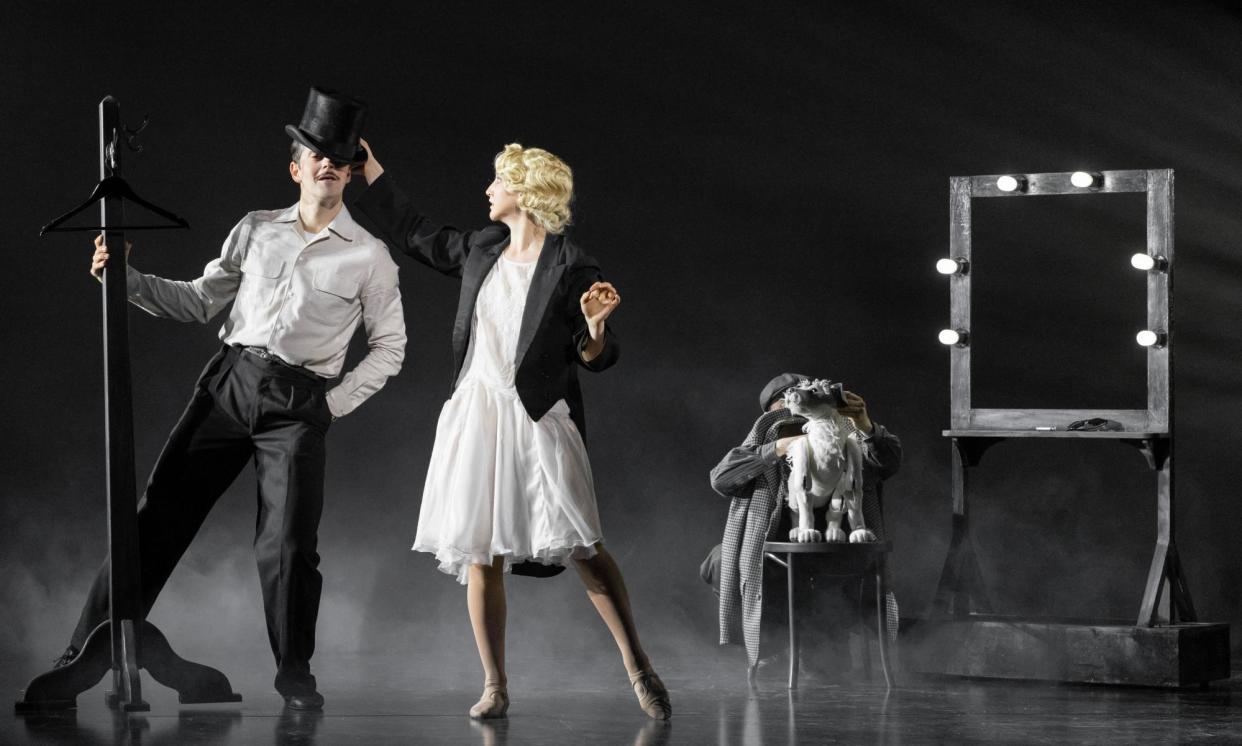‘All anyone will care about is the dog!’ Oscar sensation The Artist hits the stage – but can Uggie boogie?

One day, we will tell our grandchildren about that time in 2012 when a black-and-white French film set in the silent era, featuring only a few words of spoken dialogue, bagged five Oscars including best picture, and grossed $133m at the box office. Will they stare at us as if we’ve been bopped on the head by a Keystone Kop?
The Artist charts the rise of Peppy Miller, a young dancer whose screen ascendancy coincides with the fall of George Valentin, a matinee idol resistant to the incoming talkies. The charming comedy, directed by Michel Hazanavicius, felt like a tonic as well as an anomaly. Now the question is whether its pleasures will survive in another medium. A near-wordless picture about early-20th-century film has a certain logic. But can a silent movie work on stage?
“The gift we have in theatre is the liveness of sound,” says Drew McOnie, the new version’s director, choreographer and co-writer, when we meet during rehearsals at a London studio. “For a play that uses the metaphor of the world changing as sound arrives, and a young woman finding her voice, the electricity of live sound brings an inherent theatricality.” Whereas no one in the film utters a word until the final seconds, this adaptation switches from screen captions to dialogue with the arrival of sound. Except, that is, for George, who continues to speak in captions, holding out against change even as he expresses his inner self through dance.
“He has a choice,” says McOnie. “He can move forward, or stay where he is and become irrelevant. It’s a question we all face: how do we respond to the world changing?” Although the actor and dancer Robbie Fairchild, who brings panache to the role of George, is only 36, he has felt a twinge of looming obsolescence. “The young dancers come in and they’re all doing these TikToks,” he says, wrinkling his nose. “So I know how George feels.”
Newcomer Briana Craig also feels some kinship with her character. “Peppy and I are so similar,” she gasps. “She holds her ground and that’s something I’ve always done. Sometimes, I don’t know whether I’m talking about Peppy or myself.”
The showbiz stalwart Gary Wilmot, who plays studio head Al Zimmer, admits to a different sort of confusion. “We had a read-through on Zoom and at the end I went, ‘I’m none the wiser!’ It’s mostly stage directions, the odd line here or there. It’s the dance and movement that links it all up. That’s scary for someone like me, who talks for a living.”
The production mixes dance with an original score by Simon Hale that puts new twists on old standards. “Musically,” he says, “I’ve represented the coming modernity by using discordant harmonies, or going into jazz and bebop. That’s a bit ahead of the 1920s and 30s, but it expresses the shock of the new.”
Music helps usher the show along. “There’s a transition from silent-movie ballet into a play,” says McOnie. “Then the romance kicks in and the singing starts. By the end, we’re in an all-singing, all-dancing MGM-style musical. The form changes to correspond with the emotional arc.”
Several new characters appear, including a fast-talking reporter named Gertie Gams. But as Hazanavicius warned when McOnie first pitched the stage version: “All anyone will care about is the dog.” McOnie’s co-writer, the playwright Lindsey Ferrentino, laughs at this. “My first question to Drew was exactly that, ‘How will we do Uggie?’”
No one who has seen the film will forget George’s pet, a parson russell terrier, who saves the day – and steals the movie. The puppetry director and designer Maia Kirkman-Richards has built a batch of Uggies to suit the assorted feats demanded of him, which include dancing, carrying things in his mouth and moving in slow-motion.
During the run-through, one dormant Uggie dozes in his basket while another is operated by dancer Thomas Walton, who moves with his own puppyish energy. “Because Thomas isn’t a puppeteer,” says Kirkman-Richards, “he’s been suggesting things that break the rules, such as him looking one way while Uggie looks the other. If we’re going to have a dancer as the puppeteer, it makes sense to use their body.”
This works a treat, with Walton acting as a kind of mirror personality to the dog, looking excitable or exasperated himself, according to Uggie’s mood. By the time he brings the puppet scampering over to me during a break, Uggie has become so lifelike I don’t feel remotely silly reaching down to tickle his tummy or rub behind his ears. Even Griz, Fairchild’s toy Australian shepherd, was fooled.
“They were playing together like little dogs do,” the actor says. “Griz was pushing his butt back, gnawing on his neck, having the best time.” It’s an encouraging sign that, in putting The Artist on stage, McOnie isn’t barking up the wrong tree.
• The Artist is at the Theatre Royal, Plymouth, until 25 May


